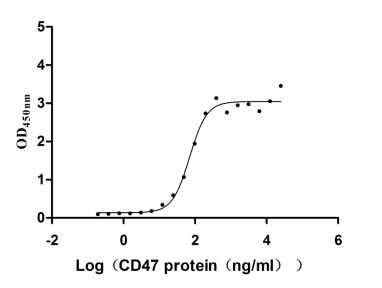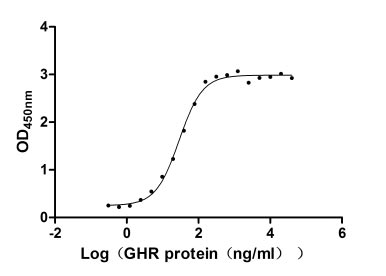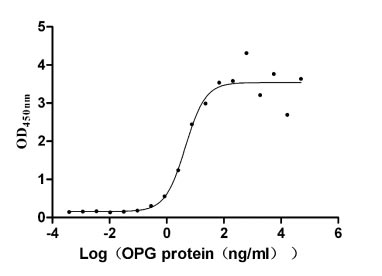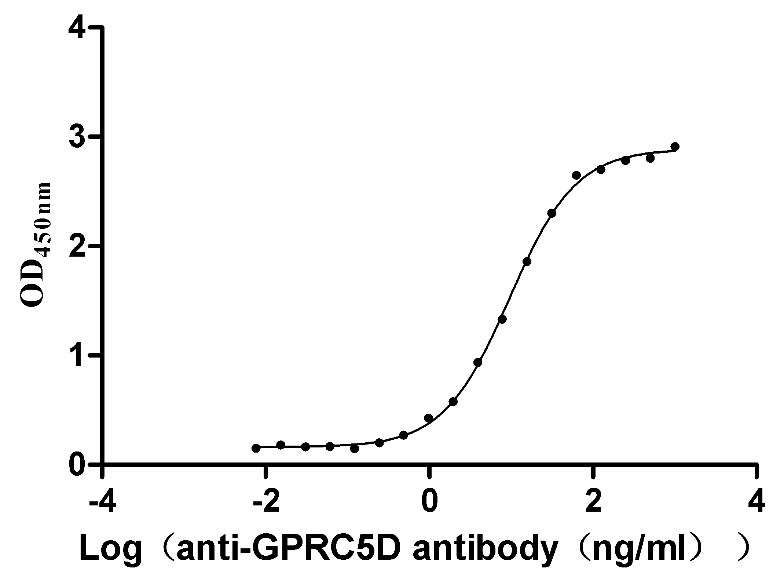Recombinant Salmonella typhimurium Chaperone protein YajL (yajL)
-
中文名称:鼠伤寒沙门菌yajL重组蛋白
-
货号:CSB-YP345912SXB
-
规格:
-
来源:Yeast
-
其他:
-
中文名称:鼠伤寒沙门菌yajL重组蛋白
-
货号:CSB-EP345912SXB
-
规格:
-
来源:E.coli
-
其他:
-
中文名称:鼠伤寒沙门菌yajL重组蛋白
-
货号:CSB-EP345912SXB-B
-
规格:
-
来源:E.coli
-
共轭:Avi-tag Biotinylated
E. coli biotin ligase (BirA) is highly specific in covalently attaching biotin to the 15 amino acid AviTag peptide. This recombinant protein was biotinylated in vivo by AviTag-BirA technology, which method is BriA catalyzes amide linkage between the biotin and the specific lysine of the AviTag.
-
其他:
-
中文名称:鼠伤寒沙门菌yajL重组蛋白
-
货号:CSB-BP345912SXB
-
规格:
-
来源:Baculovirus
-
其他:
-
中文名称:鼠伤寒沙门菌yajL重组蛋白
-
货号:CSB-MP345912SXB
-
规格:
-
来源:Mammalian cell
-
其他:
产品详情
-
纯度:>85% (SDS-PAGE)
-
基因名:yajL
-
Uniprot No.:
-
别名:yajL; STM0433; Protein/nucleic acid deglycase YajL; EC 3.1.2.-; EC 3.5.1.-; EC 3.5.1.124; Chaperone protein YajL; Maillard deglycase
-
种属:Salmonella typhimurium (strain LT2 / SGSC1412 / ATCC 700720)
-
蛋白长度:full length protein
-
表达区域:1-196
-
氨基酸序列MSAQALVCLA PGSEETEAVT TIDLLVRGGI HVTTASVASD GNLTIVCSRG VKLLADAPLV EVADGDYDII VLPGGIKGAE CFRDSPLLVE TVKQFHRSGR IVAAICAAAA TVLVPHDIFP IGNMTGFPAL KDKIPAEQWL DKRVVWDARV KLLTSQGPGT AIDFGLKIID LLAGREKAHE VASQLVMAAG IYNYYE
-
蛋白标签:Tag type will be determined during the manufacturing process.
The tag type will be determined during production process. If you have specified tag type, please tell us and we will develop the specified tag preferentially. -
产品提供形式:Lyophilized powder
Note: We will preferentially ship the format that we have in stock, however, if you have any special requirement for the format, please remark your requirement when placing the order, we will prepare according to your demand. -
复溶:We recommend that this vial be briefly centrifuged prior to opening to bring the contents to the bottom. Please reconstitute protein in deionized sterile water to a concentration of 0.1-1.0 mg/mL.We recommend to add 5-50% of glycerol (final concentration) and aliquot for long-term storage at -20℃/-80℃. Our default final concentration of glycerol is 50%. Customers could use it as reference.
-
储存条件:Store at -20°C/-80°C upon receipt, aliquoting is necessary for mutiple use. Avoid repeated freeze-thaw cycles.
-
保质期:The shelf life is related to many factors, storage state, buffer ingredients, storage temperature and the stability of the protein itself.
Generally, the shelf life of liquid form is 6 months at -20°C/-80°C. The shelf life of lyophilized form is 12 months at -20°C/-80°C. -
货期:Delivery time may differ from different purchasing way or location, please kindly consult your local distributors for specific delivery time.Note: All of our proteins are default shipped with normal blue ice packs, if you request to ship with dry ice, please communicate with us in advance and extra fees will be charged.
-
注意事项:Repeated freezing and thawing is not recommended. Store working aliquots at 4°C for up to one week.
-
Datasheet :Please contact us to get it.
靶点详情
-
功能:Protein and nucleotide deglycase that catalyzes the deglycation of the Maillard adducts formed between amino groups of proteins or nucleotides and reactive carbonyl groups of glyoxals. Thus, functions as a protein deglycase that repairs methylglyoxal- and glyoxal-glycated proteins, and releases repaired proteins and lactate or glycolate, respectively. Deglycates cysteine, arginine and lysine residues in proteins, and thus reactivates these proteins by reversing glycation by glyoxals. Is able to repair glycated serum albumin, collagen, glyceraldehyde-3-phosphate dehydrogenase, and fructose biphosphate aldolase. Acts on early glycation intermediates (hemithioacetals and aminocarbinols), preventing the formation of Schiff bases and advanced glycation endproducts (AGE) that cause irreversible damage. Also functions as a nucleotide deglycase able to repair glycated guanine in the free nucleotide pool (GTP, GDP, GMP, dGTP) and in DNA and RNA. Is thus involved in a major nucleotide repair system named guanine glycation repair (GG repair), dedicated to reversing methylglyoxal and glyoxal damage via nucleotide sanitization and direct nucleic acid repair. However, is less efficient than Hsp31 and YhbO, suggesting that YajL might be preferentially dedicated to protein repair. Displays a covalent chaperone activity with sulfenylated thiol proteins by forming mixed disulfides with members of the thiol proteome, and preferentially with sulfenylated cellular proteins, upon oxidative stress; these mixed disulfides can be subsequently reduced by low-molecular-weight thiols to regenerate YajL and reduced proteins. Involved in biogenesis of ribosomal proteins, probably as a ribosomal protein-folding chaperone. Confers resistance to oxidative stress. Plays an important role in protection against electrophile/carbonyl stress. The chaperone activity reported for YajL is probably recruited to execute its deglycase activity, to interact with non-native glycated proteins and gain access to partially buried glycated sites. Also displays an apparent glyoxalase activity that in fact reflects its deglycase activity.
-
蛋白家族:Peptidase C56 family
-
数据库链接:
KEGG: stm:STM0433
STRING: 99287.STM0433
Most popular with customers
-
Express system: Mammalian cell
Species: Homo sapiens (Human)
-
Recombinant Human Growth hormone receptor (GHR), partial (Active)
Express system: Mammalian cell
Species: Homo sapiens (Human)
-
Recombinant Human Tumor necrosis factor receptor superfamily member 11B (TNFRSF11B) (Active)
Express system: Mammalian cell
Species: Homo sapiens (Human)
-
Recombinant Human G-protein coupled receptor family C group 5 member D (GPRC5D)-VLPs (Active)
Express system: Mammalian cell
Species: Homo sapiens (Human)
-
Recombinant Mouse Retinol-binding protein 4 (Rbp4) (Active)
Express system: Mammalian cell
Species: Mus musculus (Mouse)
-
Recombinant Dog B-lymphocyte antigen CD20 (MS4A1)-VLPs (Active)
Express system: Mammalian cell
Species: Canis lupus familiaris (Dog) (Canis familiaris)
-
Recombinant Human IL12B&IL12A Heterodimer Protein (Active)
Express system: Mammalian cell
Species: Homo sapiens (Human)
-
Recombinant Human Carcinoembryonic antigen-related cell adhesion molecule 6 (CEACAM6) (Active)
Express system: Mammalian cell
Species: Homo sapiens (Human)




















